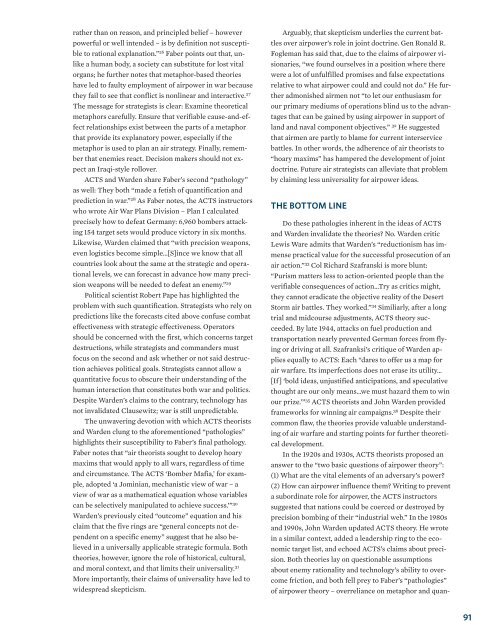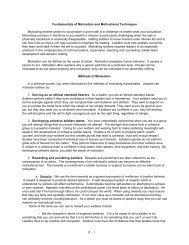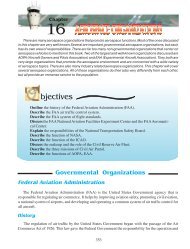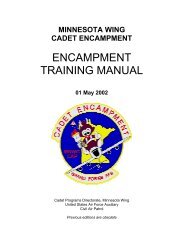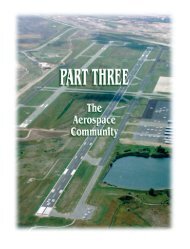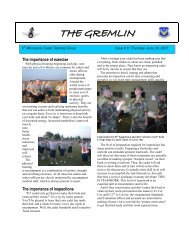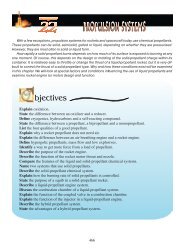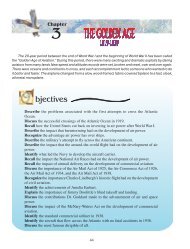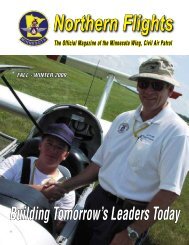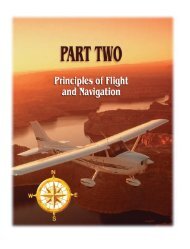ecomes one of applying sufficient indirect pressure sothat the command element rationally concludes that concessionsare appropriate, realizes that further action isimpossible, or is physically deprived of the ability to…continuecombat.” 14 If unable, then, to attach the center leadershipring directly, Warden recommended attacks onorganic essentials such as power production and petroleum– precisely the targets identified by ACTS. He proposedthat damage to organic essentials could lead to“collapse of the system” or “internal political or economicrepercussions that are too costly to bear” 15 – in otherwords, to the “fatal weakening” suggested by ACTS. Finally,just as the ACTS theorists refused to squanderbombing on Army support operations, Warden emphasizedthat “engagement of the enemy military…should beavoided under most circumstances.” Fighting an enemy’smilitary “is at best a means to an end and at worst a totalwaste of time and energy” [emphasis in original]. 16In essence, Warden just updated ACTS theory. Themajor thematic difference between the theories is the additionof a new “vital center” – the leadership ring – andtwo new destructive mechanisms to influence that centerof gravity: decapitation and parallel war. Nuclear strategistscoined the first term to describe the killing or isolationof enemy leaders; Warden created the second todescribe the overwhelming-force strategy to use whenthe leaders were unreachable. A “death of 1,000 cuts”would suffice to collapse an enemy system whose centerring was protected, just as ACTS proposed to disrupt theindustrial web. Technology improved the execution of thestrategy, however, allowing airmen to inflict those cutsnearly simultaneously. Warden noted that Desert Stormair forces “struck three times as many targets in Iraq inthe first 24 hours as Eighth <strong>Air</strong> Force hit in Germany inall of 1943.” 17UNDERLYING ASSUMPTIONSGiven the similarities in context and content that connectthese bodies or airpower thought, it should not besurprising to discover that they rest on similar assumptions.Most importantly, they presuppose a rational actor,or, to use Graham Allison’s term, Model I enemy. Wardenproposed that “enemies, whether they be states, criminalorganizations, or individuals all do the same thing: theyalmost always act or don’t act based on some kind of costbenefitratio.” 18 Faber made the same observation aboutACTS, whose theorists overlooked the fact that an enemymight operate based on “potentially obscure organizational,bureaucratic, or emotional” Model II/III factors. 19Faber also pointed out that ACTS theory rested on a“mid-Victorian faith in technology” and “wrongly assumedthat revolutionary bomber-related technologieswould produce almost ‘frictionless’ wars.” 20 Wardenechoed this faith, consigning friction to the Napoleonicera. In Warden’s combat equation, modern airmen couldignore morale (and friction, a morale-related factor) becausephysical factors x morale = outcome. When physicalfactors approach zero due to technologically superiorattacks, output of the enemy war machine will be zero,regardless of morale factors – and friction is therefore irrelevant.21Clearly, these assumptions lead to problems. Due toits simplicity, a rational-actor model cannot adequatelydescribe or predict the behavior of many state and nonstateactors. Faber, for example, asks, “Is it not possible…that a state might continue to struggle – at higher costs –to demonstrate its resolve in future contingencies?” 22 If astrategist cannot determine how an opponent will reactto pressure – if the Model I analysis is faulty – then hecannot effectively target the opponent’s will or force himto change his mind à la Warden and ACTS. A belief infrictionless war seems fraught with peril, as well. Gordonand Trainor devote a full chapter to describing numerousinstances of friction in the Gulf War; Lt Col Barry D.Watts uses an entire book to show how twentieth-centurywarfare is characterized by friction. “The very structureof human cognition,” he concludes, “argues that frictionwill continue to be the fundamental atmosphere of war.” 23These flawed underlying assumptions cast doubt on thevalidity of both theories and suggest additional questions.Do the ACTS and Warden theories share other flaws? Ifthey do, are they relevant to airpower strategists in thecoming years?HOLES IN THE LOGICThe theories do, in fact, contain additional relatedflaws that highlight lessons for future strategists. Fabercharacterizes these flaws as the “three pathologies” ofairpower theory. One of the pathologies is an overrelianceon metaphor in place of logical argumentation. 24 ACTStheorists and Warden provided little evidence to supporttheir “web” and “body” analogies. Warden merely rearrangeda tabular presentation of system componentsinto rings and claimed – without empirical data – that thediagram proved “several key insights,” namely that therings were interdependent, the center was most important,that the military was merely a shield for the others,and effectiveness lay in working inside-out vice outsidein.25 Warden also failed to provide proof that a nationstate,like a body, could be killed through decapitation.Similarly, the ACTS theorists described an economic“house of cards” using a sample size of one – the Americaneconomy of the 1930s.Critiquing Warden, Dr. Lewis Ware notes that suchunsupported metaphors are inadequate as analytical instruments.Their “arguments rest on principled belief90
ather than on reason, and principled belief – howeverpowerful or well intended – is by definition not susceptibleto rational explanation.” 26 Faber points out that, unlikea human body, a society can substitute for lost vitalorgans; he further notes that metaphor-based theorieshave led to faulty employment of airpower in war becausethey fail to see that conflict is nonlinear and interactive. 27The message for strategists is clear: Examine theoreticalmetaphors carefully. Ensure that verifiable cause-and-effectrelationships exist between the parts of a metaphorthat provide its explanatory power, especially if themetaphor is used to plan an air strategy. Finally, rememberthat enemies react. Decision makers should not expectan Iraqi-style rollover.ACTS and Warden share Faber’s second “pathology”as well: They both “made a fetish of quantification andprediction in war.” 28 As Faber notes, the ACTS instructorswho wrote <strong>Air</strong> War Plans Division – Plan I calculatedprecisely how to defeat Germany: 6,960 bombers attacking154 target sets would produce victory in six months.Likewise, Warden claimed that “with precision weapons,even logistics become simple…[S]ince we know that allcountries look about the same at the strategic and operationallevels, we can forecast in advance how many precisionweapons will be needed to defeat an enemy.” 29Political scientist Robert Pape has highlighted theproblem with such quantification. Strategists who rely onpredictions like the forecasts cited above confuse combateffectiveness with strategic effectiveness. Operatorsshould be concerned with the first, which concerns targetdestructions, while strategists and commanders mustfocus on the second and ask whether or not said destructionachieves political goals. Strategists cannot allow aquantitative focus to obscure their understanding of thehuman interaction that constitutes both war and politics.Despite Warden’s claims to the contrary, technology hasnot invalidated Clausewitz; war is still unpredictable.The unwavering devotion with which ACTS theoristsand Warden clung to the aforementioned “pathologies”highlights their susceptibility to Faber’s final pathology.Faber notes that “air theorists sought to develop hoarymaxims that would apply to all wars, regardless of timeand circumstance. The ACTS ‘Bomber Mafia,’ for example,adopted ‘a Jominian, mechanistic view of war – aview of war as a mathematical equation whose variablescan be selectively manipulated to achieve success.’” 30Warden’s previously cited “outcome” equation and hisclaim that the five rings are “general concepts not dependenton a specific enemy” suggest that he also believedin a universally applicable strategic formula. Boththeories, however, ignore the role of historical, cultural,and moral context, and that limits their universality. 31More importantly, their claims of universality have led towidespread skepticism.Arguably, that skepticism underlies the current battlesover airpower’s role in joint doctrine. Gen Ronald R.Fogleman has said that, due to the claims of airpower visionaries,“we found ourselves in a position where therewere a lot of unfulfilled promises and false expectationsrelative to what airpower could and could not do.” He furtheradmonished airmen not “to let our enthusiasm forour primary mediums of operations blind us to the advantagesthat can be gained by using airpower in support ofland and naval component objectives.” 32 He suggestedthat airmen are partly to blame for current interservicebattles. In other words, the adherence of air theorists to“hoary maxims” has hampered the development of jointdoctrine. Future air strategists can alleviate that problemby claiming less universality for airpower ideas.THE BOT<strong>TO</strong>M LINEDo these pathologies inherent in the ideas of ACTSand Warden invalidate the theories? No. Warden criticLewis Ware admits that Warden’s “reductionism has immensepractical value for the successful prosecution of anair action.” 33 Col Richard Szafranski is more blunt:“Purism matters less to action-oriented people than theverifiable consequences of action…Try as critics might,they cannot eradicate the objective reality of the DesertStorm air battles. They worked.” 34 Similiarly, after a longtrial and midcourse adjustments, ACTS theory succeeded.By late 1944, attacks on fuel production andtransportation nearly prevented German forces from flyingor driving at all. Szafranksi’s critique of Warden appliesequally to ACTS: Each “dares to offer us a map forair warfare. Its imperfections does not erase its utility…[If ] ‘bold ideas, unjustified anticipations, and speculativethought are our only means…we must hazard them to winour prize.’” 35 ACTS theorists and John Warden providedframeworks for winning air campaigns. 36 Despite theircommon flaw, the theories provide valuable understandingof air warfare and starting points for further theoreticaldevelopment.In the 1920s and 1930s, ACTS theorists proposed ananswer to the “two basic questions of airpower theory”:(1) What are the vital elements of an adversary’s power?(2) How can airpower influence them? Writing to preventa subordinate role for airpower, the ACTS instructorssuggested that nations could be coerced or destroyed byprecision bombing of their “industrial web.” In the 1980sand 1990s, John Warden updated ACTS theory. He wrotein a similar context, added a leadership ring to the economictarget list, and echoed ACTS’s claims about precision.Both theories lay on questionable assumptionsabout enemy rationality and technology’s ability to overcomefriction, and both fell prey to Faber’s “pathologies”of airpower theory – overreliance on metaphor and quan-91
- Page 1 and 2:
VOLUME FOUR STRATEGIC PERSPECTIVESL
- Page 3 and 4:
VOLUME FOUR STRATEGIC PERSPECTIVESL
- Page 5 and 6:
VOLUME FOUR STRATEGIC PERSPECTIVESL
- Page 7:
VOLUME FOUR STRATEGIC PERSPECTIVESL
- Page 10 and 11:
12CHAPTER 12INTRODUCTION TO STRATEG
- Page 12 and 13:
12.1 Strategic Leadership: Defining
- Page 14 and 15:
mandates or resolutions that would
- Page 16 and 17:
and ambiguity, aspiring strategic l
- Page 18 and 19:
12.2 National Security StrategyThe
- Page 20 and 21:
within our borders has always been
- Page 22 and 23:
front common challenges like violen
- Page 24 and 25:
and our strategy, not sector earmar
- Page 26 and 27:
thinking about organizations. She m
- Page 28 and 29:
A systemic approach to failure is m
- Page 30 and 31:
The late W. T. Grant Company is a r
- Page 32 and 33:
the resources - setting the directi
- Page 34 and 35:
focal point for describing and inte
- Page 36 and 37:
Consequently, we do not restrict th
- Page 38 and 39:
paragraphs, Web pages, then edit an
- Page 40 and 41:
Web, can be viewed as a CS attempt
- Page 42 and 43: How to evaluate users and contribut
- Page 44 and 45: 13CHAPTER 13LEADING PUBLIC &VOLUNTE
- Page 46 and 47: 13.1 Leadership for Volunteers:The
- Page 48 and 49: 13.2 Take Root: Volunteer Managemen
- Page 50 and 51: QualificationsClearly list educatio
- Page 52 and 53: and effectively track their volunte
- Page 54 and 55: • Understand rules for recognitio
- Page 56 and 57: • Send a birthday card.• Submit
- Page 58 and 59: and tested more than six decades af
- Page 60 and 61: specific interests of the donors, v
- Page 62 and 63: tain) tax-exempt status from the In
- Page 64 and 65: Smucker, 1999).The Internal Revenue
- Page 66 and 67: culture is necessary to ensure the
- Page 68 and 69: 13.4 The New Look of TransparencyBy
- Page 70 and 71: ees for a couple of reasons: One, i
- Page 72 and 73: 13.5 Public and Private Management:
- Page 74 and 75: TABLE 1:FUNCTIONS OF GENERAL MANAGE
- Page 76 and 77: 3. Career System. The model corpora
- Page 78 and 79: islative charter - the Clean Air Ac
- Page 80 and 81: In controlling performance, Chapin
- Page 82 and 83: 14CHAPTER 14AIRPOWER ASSTRATEGIC LA
- Page 84 and 85: 14.1 Strategic Air Power: Fulfillme
- Page 86 and 87: carry it out. Their daylight raids
- Page 88 and 89: you did not rely on strategic bombi
- Page 90 and 91: 14.2 Warden and the Air Corps Tacti
- Page 94 and 95: tification, and a Jominian claim to
- Page 96 and 97: courage the rapid and widespread ex
- Page 98 and 99: it to influence physical players in
- Page 100 and 101: 14.4 Basic Air Force DoctrineAF Doc
- Page 102 and 103: earthquake-stricken Haiti. The worl
- Page 104 and 105: perspective. Airmen do not divide u
- Page 106 and 107: Command and ControlCommand and cont
- Page 108 and 109: 14.5 Should the US Maintain the Nuc
- Page 110 and 111: form of human government.” 20 Dem
- Page 112 and 113: obtainable goal. See the Global Zer
- Page 114 and 115: 15CHAPTER 15ORGANIZATIONAL CULTURE
- Page 116 and 117: 15.1 Organizational CultureBy Doria
- Page 118 and 119: Review. This action strives to unco
- Page 120 and 121: gram will serve and then having the
- Page 122 and 123: ticipating the changes being made b
- Page 124 and 125: Many years of working with change p
- Page 126 and 127: At the least, the areas of concern
- Page 128 and 129: 15.4 Developing an Innovative Cultu
- Page 130 and 131: CONCLUDING THOUGHTSIn an ever-chang
- Page 132 and 133: global issues. Businesses that poss
- Page 134 and 135: — Sees the big picture—the shif
- Page 136 and 137: 16CHAPTER 16STRATEGIC COMMUNICATION
- Page 138 and 139: 16.1 Principles of Strategic Commun
- Page 140 and 141: 16.2 The Art of NegotiationBy Brend
- Page 142 and 143:
16.3 Negotiating Effectively Across
- Page 144 and 145:
hidden areas can act as cultural ho
- Page 146 and 147:
and four conflict styles. Hammer be
- Page 148 and 149:
maintaining the relationship. As th
- Page 150 and 151:
25 Mitchell R. Hammer, “Chapter 1
- Page 152 and 153:
tural, socioeconomic, and psycholog
- Page 154 and 155:
for the win-win," during which time
- Page 156 and 157:
interests and, at worst, as a gun s
- Page 158 and 159:
Public diplomacy is surely about mu
- Page 160 and 161:
But public diplomats do not have th
- Page 162 and 163:
Photo courtesy of the familyThe LEA
- Page 164:
THE CADET OATHI pledge that I will


